Art Auctions Without the Attitude
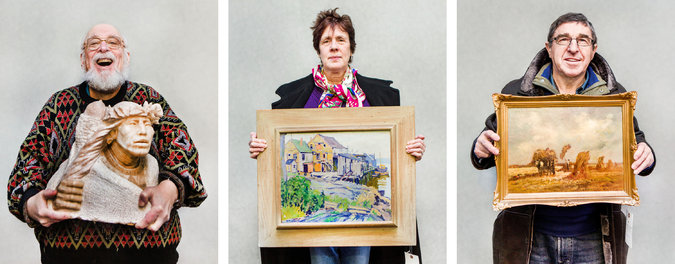
Sold! From left, at Capo Auction: Joel Kramer with an alabaster sculpture of a Native American; Jenine Linder with a painting by Ernest Nathaniel Townsend; and Henry Radziulis with a work by Max Heichele. Credit Piotr Redlinski for The New York Times
EILEEN OGLE of Brooklyn comes so often to shop at Hutter Auction Galleries on West 55th Street in Manhattan that she admits she may have a bit of “collectivitis.”
“Eighty percent of my apartment is stuff from here,” she said one day last month.
Jessica Dubensky spends many Saturdays at another auction house, Capo Auction in Long Island City, Queens, next to an auto repair shop and across from the elevated tracks of the No. 7 train. She has bought numerous seascapes to hang in an ocean-theme bathroom at her home in Forest Hills, Queens.
So when Lot No. 23 — “Boats at the Dock,” by a little-known Brazilian painter — came up for sale at Capo one Saturday last month, Ms. Dubensky, a 31-year-old bank compliance officer, raised her hand shyly. A moment later, it was hers, for $150.
“It is really fun and it is exciting to bid,” Ms. Dubensky said as the subway rattled past. “But mostly, I really like the art.”
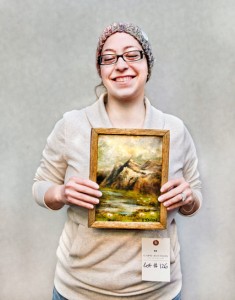
At Capo Auction House in Queens, Jessica Dubensky bought a Eugene Leibert painting. Credit Piotr Redlinski for The New York Times
There are many delights to auctions at megaliths like Sotheby’s or Christie’s, where the competition can be electric, the sums staggering and the audience filled with collectors who covet, and know, their art. But the astronomical prices, the negotiated guarantees, the cycle of sale and resale for some works, have heightened the scent of commerce in such transactions.
There are lower prices, no air-kissing and not as much scholarship at places like Hutter and Capo and the many smaller auction houses like them across the United States that sell a range of items, not just fine art. But what is often evident in the buyers is a certain simple, refreshing love for the art and for a bargain.
“Some people like their landscapes, some people like their seascapes, some like their abstract works,” said Amy Papola, 44, Capo’s auctioneer. “You can get some things very cheaply.”
Hutter and Capo are two of the several thousand auction companies in the United States. In New York State alone, some 75 auction houses sell fine art, industry experts estimate, most of them operating in the same small-to-middle range where most lots sell for a few hundred dollars, or a few thousand, and rarely more than $50,000.
Capo, for example, will sell about $3 million worth of items a year, its owners said, just a speck next to the $3.8 billion that Sotheby’s sold in 2012.
And the smaller auctions have a decidedly different vibe. Capo holds sales on Saturdays, so its customers can park outside easily. It offers breakfast (bagels and coffee) and lunch (pizza, on one recent Saturday) to keep the buyers in their seats for as long as possible.
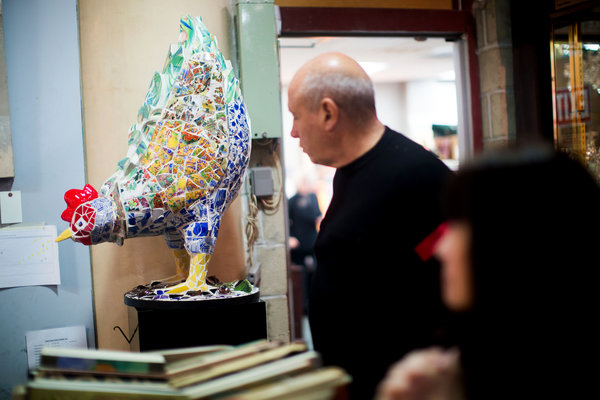
Larry Berman, a co-owner of Capo Auction House, with a ceramic chicken sculpture. Credit Piotr Redlinski for The New York Times
From 10 a.m. to 2 p.m. on the Wednesday before each month’s auction, Capo’s chief appraiser, Karen Cangelosi, a diminutive woman who often wears a black smock, offers free drop-in appraisals for prospective sellers.
But small is beautiful to buyers like Ms. Ogle, 50, who is majoring in art history at New York University and remembers her first impression years ago when she came upon the tumble of baubles and beads and paintings and sculpture in a small auction room. It was, she said, “like a cave in Aladdin.”
Adam Hutter, who owns Hutter Auction, said that about half his buyers are dealers, and half are people buying for themselves. Gary Karakashian, a dermatologist from New Jersey, shops at the big houses and the smaller auction businesses, such as Roland Antiques in Greenwich Village, where recently, he said, he bought a pair of abstract paintings, $90 for the two. He does not sniff at such bargains, though he certainly has spent more, he said. “When I put the inexpensive things together with the expensive things, the inexpensive things don’t look so bad,” he said.
At Capo, one buyer, Henry Radziulis, 62, a retired carpenter from Queens, said he had more traditional taste and liked pictures that remind him of his homeland, Poland. He bought “Baling Hay,” an oil on board, for $500 at the auction there last month.
“Here anyone can walk in,” Capo’s co-owner Larry Berman said. “What we have here is for the masses. Most people feel uncomfortable going to Christie’s or Sotheby’s. We are trying to lure them into coming into Queens.”
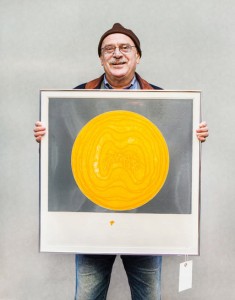
Babis Efstathiou paid $30 for an abstract color litograph, signed and dated illegibly. Credit Piotr Redlinski for The New York Times
Mr. Berman, 55, admitted with a shrug that he knows little about art, although he has bought a few things himself: prints by Matisse, Miró and Calder.
He and his brother and co-owner, Robert, have run a trucking business for years from Queens warehouses, crating and shipping art for auction houses, dealers and collectors. But when one of the small Manhattan auction houses they served closed down, they decided in 2010 to try the selling business themselves, with a partner, Michael Capo, who has since left and now runs a different auction house, Beaux-Arts Auction, a few miles away, also in Long Island City.
Capo’s consignments largely come from estate sales, but also from aging baby boomers and others moving into smaller homes. Days before last month’s auction, Capo’s windowless ground floor showroom was a tangle of mirrors and chandeliers, carpets and chairs. Along one long wall, the company posed the “flat art,” or paintings: “Man Smoking Pipe,” “Boy on Stilts,” “Spanish Steps,” street scenes and country scenes, and boats, lots of boats. For the actual sale, everything was stacked away, and just photographs of the items were shown during the bidding.
Though chairs had been put out for 71 buyers, many were empty. In addition, there were a handful of dealers, some from Manhattan, in the back of the room, sitting on $500 sofas, looking for a bargain — or a “sleeper” — they might resell.
Some people phoned in their bids. About 340 other buyers registered to bid online, including eight from China. As the auction proceeded, Ms. Papola prodded her customers. “Every piece has a home,” she chirped.
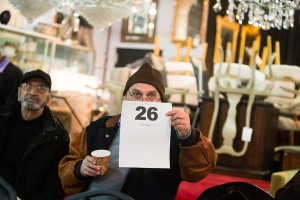
Babis Efstathiou during a fine art auction at Capo Auction House in Queens. Credit Piotr Redlinski for The New York Times
But buyers balked at many of the more than 700 lots. No one wanted the fish knives. The vintage clothes were a dud. A sculpture by the Finnish artist Rut Bryk was the top selling artwork, going for $7,000 to a phone buyer from Potomac, Md.
Each buyer had his or her own calculus for deciding what to buy. Joel Kramer, 70, a retired actor, bought a carved alabaster figure of a Native American with an eagle for $150.
Jenine Lindner, 65, of Manhattan, bought three paintings at Capo: a fishing scene for $250, a landscape for $100 and a portrait of a young woman for $50.
Ms. Lindner said that as a child she accompanied her mother, who painted in oils, when she showed at outdoor art fairs in Greenwich Village. She is attracted to work by artists like George Bellows and others from the Ashcan School.
“There is so much good art out there,” she said, “for a little bit of money.”
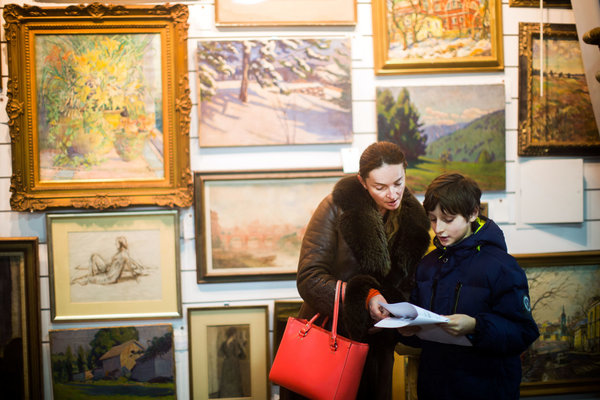
Art appreciation: Victoria Riggs and her son Winston at a preview day at Capo Auction in Long Island City, Queens. Credit Piotr Redlinski for The New York Times
Even if she had the money, she would prefer shopping in smaller auction settings to the large Manhattan sales rooms, which she described as “snooty.”
“I just find it silly,” she said. “You have to have a certain look. They spend billions of dollars on art. It is money that could be better spent.”
For her part, Ms. Dubensky, who bought a few more paintings, including a mountain scene for $80, said she had never been to a big auction in Manhattan. But she said that she imagined the million-dollar price tags were probably worth it, and not a sign of excess.
“It would be beyond exciting” to go, she said. “Unfortunately, I can’t afford it.”
By Graham Bowley
Source: http://www.nytimes.com